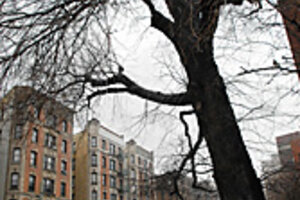'Cloning' comes to trees in new preservation push
To keep natural history alive, a New York program tries grafting ancient giants.

Dinosaur: A New York City elm dating to the American Revolution is among many historic trees to be 'cloned'.
Mary Knox Merrill — Staff
New York
For generations, the towering English Elm has presided over the intersection of 163rd St. and St. Nicholas Ave., in the Washington Heights neighborhood of upper Manhattan. Fifty-three blocks from the tip of Central Park, the "dinosaur," as residents fondly call it, might have served as a natural gateway for Gen. George Washington, rumored to have passed under its boughs at the onset of the Revolutionary War.
But the tree is starting to show its age. Plastic trash hangs from its branches, and a thick black rope, coiled tightly across the trunk, holds one frail limb from crashing onto the street below.
Years ago, city officials erected a small fence around the tree's perimeter to keep hands off its flaking bark.
Now, they have undertaken a more permanent – and distinctly modern – scientific solution. This winter, the New York City Department of Parks and Recreation, working with Bartlett Tree Experts, a Connecticut company, began extracting cuttings from 25 of Manhattan's most historically significant trees.
Those cuttings will be shipped to an Oregon nursery, which will effectively clone the tree by grafting a branch onto the root stock of a similar species. Program manager Matthew Wells says he hopes that complete saplings can be planted within two to three years in Manhattan's public places, or near area schools, where they would serve as natural landmarks.
"There's a widespread recognition that there are certain 'great trees,' and that they're meaningful to our shared history, and to a sense of place," says Bram Gunther, the deputy chief of forestry and horticulture for the Parks Department. "And we should be thinking about preserving those trees just as we would a famous painting in a museum."
In recent years, several organizations have begun "cloning" historic trees, including an effort to preserve specimens from the estates of George Washington and Thomas Jefferson, and from Sagamore Hill, Theodore Roosevelt's home in Oyster Bay, N.Y.
Last year, Champion Tree Project International, a nonprofit involved in the New York City initiative, collected clippings from the largest – and most ancient – California redwoods. At the time, Champion's David Milarch told reporters that the hope was eventually to create a "genetic library" for future generations.
"This is a very different type of work than, say, traditional [conservation] work in Van Cortlandt Park," Mr. Gunther says, referring to the 1,146 acre park in the northwest corner of the Bronx. "Van Cortlandt Park is part of our natural history. You could see it, in some fashion, a thousand years ago."
The cloning of the 25 trees, on the other hand, represented the preservation of a specific cultural history.
"Trees aren't like buildings, which you can rebuild," Mr. Wells says of the Manhattan trees, which have withstood years of pollution. "With genetics, once they're gone, they're gone."
Wells pointed out that some of the 25 trees were planted in the 19th century, by Frederick Law Olmsted. Best known as the designer of Central Park and Brooklyn's Prospect Park, Mr. Olmsted was a major advocate of green public spaces; he is regarded as one of the city's most influential architects.
"Most people would like nothing more than to walk under a tree that's identical to one Olmsted planted with his own hands," Wells says. "It's a link to the past."
Cloning is a common practice in forestry and botany, where scientists seek to reproduce healthy, long-lived specimens. David McMaster, vice president and division manager for Bartlett Tree Experts, says there's a widespread public misconception of how the process works. We tend to think of Dolly, he says, the sheep cloned by Scottish scientists in the 1990s, or a scene from a science-fiction movie. In fact, the New York project is derived from something much more "ancient."
"Grafting has been around for hundreds of years," Mr. McMaster says. It's a slow science, conducted in a greenhouse, and the success rate in cloning a specimen "is usually in the single digits. If we hit a home run, it can be in the teens."
And the clone, says James Danoff-Burg, director of environmentally sustainable growth at Columbia University here in New York, isn't a pitch-perfect replication. "Organisms are more than just their genes," Dr. Danoff-Burg says. "They're a reaction to their environment." In other words, the cloned "dinosaur" may look very different from the original. A different air quality might affect the texture of the bark; a different soil might affect its shape,or its size.
Still, Danoff-Burg says he is "exceptionally happy to see this sort of thing happening. The natural world is as much a part of history as the built world," he adds. "We don't tend to treasure it, because we don't see the fingerprints of humanity there."
McMaster calls it a sort of "epiphany." He remembers traveling to Sagamore Hill and identifying a Cousins Beech, which was a favorite of President Roosevelt. Bartlett sampled the tree, and "successfully reproduced it," as part of a larger conservation effort.
Then, a year and a half ago, a storm swept across Long Island, and leveled the Cousins Beech. Just in time, McMaster says, "we were able to close the loop."
